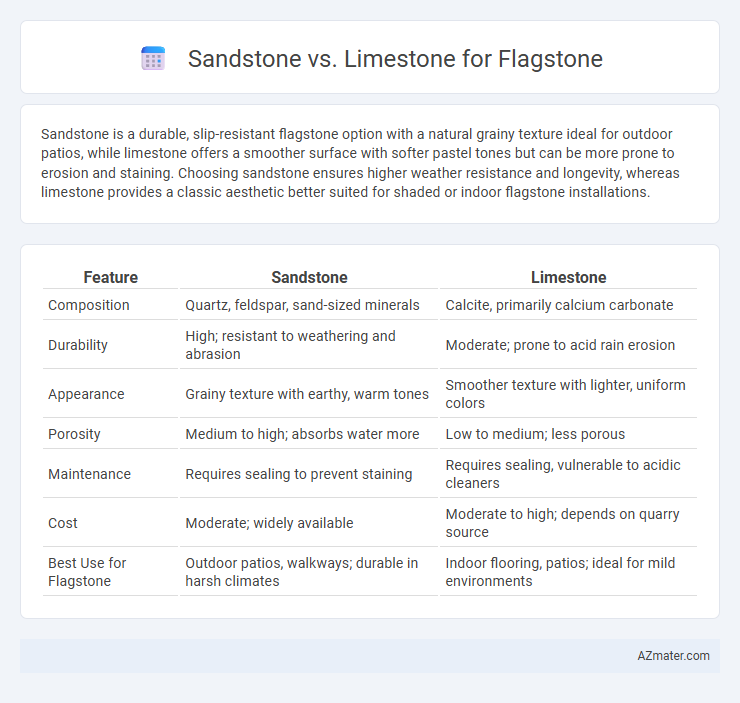Sandstone is a durable, slip-resistant flagstone option with a natural grainy texture ideal for outdoor patios, while limestone offers a smoother surface with softer pastel tones but can be more prone to erosion and staining. Choosing sandstone ensures higher weather resistance and longevity, whereas limestone provides a classic aesthetic better suited for shaded or indoor flagstone installations.
Table of Comparison
| Feature | Sandstone | Limestone |
|---|---|---|
| Composition | Quartz, feldspar, sand-sized minerals | Calcite, primarily calcium carbonate |
| Durability | High; resistant to weathering and abrasion | Moderate; prone to acid rain erosion |
| Appearance | Grainy texture with earthy, warm tones | Smoother texture with lighter, uniform colors |
| Porosity | Medium to high; absorbs water more | Low to medium; less porous |
| Maintenance | Requires sealing to prevent staining | Requires sealing, vulnerable to acidic cleaners |
| Cost | Moderate; widely available | Moderate to high; depends on quarry source |
| Best Use for Flagstone | Outdoor patios, walkways; durable in harsh climates | Indoor flooring, patios; ideal for mild environments |
Introduction to Flagstone Materials
Flagstone, commonly used for patios and walkways, is primarily crafted from sandstone and limestone due to their durability and aesthetic appeal. Sandstone features a granular texture and rich, earthy tones, making it ideal for rustic and natural designs, while limestone offers a smoother surface with softer, neutral colors suitable for elegant, classic settings. Selecting between sandstone and limestone depends on factors like climate durability, slip resistance, and desired visual texture for outdoor flagstone installations.
Overview of Sandstone and Limestone
Sandstone, a sedimentary rock composed mainly of sand-sized mineral particles or rock fragments, is prized for its durability, varied natural colors, and textured surface, making it an excellent choice for flagstone patios and walkways. Limestone, also a sedimentary rock, consists primarily of calcium carbonate and is valued for its smooth texture, light hues, and ease of shaping, suitable for more refined flagstone designs. Both materials offer unique aesthetic and structural qualities, with sandstone providing rugged strength and natural variation, while limestone delivers a softer, more uniform appearance.
Physical Properties Comparison
Sandstone and limestone differ significantly in physical properties important for flagstone use. Sandstone, composed mainly of quartz, offers higher durability and greater resistance to weathering, making it ideal for outdoor paving. Limestone, rich in calcium carbonate, tends to be softer and more porous, which can lead to faster erosion and requires more maintenance in high-traffic or wet environments.
Color and Aesthetic Differences
Sandstone flagstone offers a warm, earthy palette ranging from reds, tans, and browns, creating a rustic and natural aesthetic ideal for outdoor patios and pathways. Limestone flagstone typically features softer, neutral hues such as creamy whites, grays, and light beiges, lending a more elegant and classic appearance to landscape designs. The porous texture of sandstone produces a rougher finish, while limestone's finer grain results in a smoother surface, influencing the overall visual and tactile experience of the installed flagstone.
Durability and Longevity
Sandstone offers superior durability for flagstone applications due to its granular composition and natural resistance to weathering, making it ideal for high-traffic areas and outdoor use. Limestone, while visually appealing with its smooth texture and variety of colors, is more prone to erosion and chemical weathering, which can reduce its longevity in harsh climates. Choosing sandstone enhances the lifespan of flagstone installations, ensuring sustained strength and resistance against cracking and spalling over time.
Slip Resistance and Surface Texture
Sandstone offers superior slip resistance for flagstone applications due to its naturally rough and gritty surface texture, making it ideal for outdoor pathways and patios where safety is a priority. Limestone typically has a smoother, softer surface that can become slippery when wet, requiring additional treatment or sealing to enhance traction. The choice between sandstone and limestone for flagstone hinges on balancing aesthetic preferences with the need for slip resistance and durability in various weather conditions.
Installation Process and Ease
Sandstone flagstone offers easier cutting and shaping due to its softer texture, allowing for straightforward installation with basic tools, while limestone requires more careful handling to avoid cracking, often necessitating specialized saws and adhesives. Sandstone's natural cleft surface provides excellent traction and slip resistance during installation, whereas limestone's smoother finish may require additional surface treatment to enhance grip. Both materials benefit from proper substrate preparation, but sandstone typically speeds up the installation process due to its workability and consistent thickness.
Maintenance and Cleaning Requirements
Sandstone flagstone requires regular sealing to prevent water absorption and staining due to its porous nature, making routine cleaning with mild detergents essential to maintain its appearance. Limestone flagstone, being softer and more prone to scratching and etching, demands gentle cleaning methods, avoiding acidic or abrasive cleaners that can damage its surface. Proper maintenance for both materials includes prompt removal of spills and periodic resealing to enhance durability and preserve their natural beauty.
Cost Differences and Budget Considerations
Sandstone flagstone typically costs between $2 and $7 per square foot, making it a more budget-friendly option compared to limestone, which ranges from $6 to $15 per square foot due to its higher durability and aesthetic appeal. When considering installation costs, sandstone's softer texture often results in lower labor expenses, whereas limestone's density can increase cutting and finishing time, impacting the overall budget. Homeowners aiming for cost-effective landscaping should weigh the initial material price against long-term maintenance, as sandstone may require more frequent sealing and repairs than the more resilient limestone.
Best Applications: Sandstone vs Limestone
Sandstone excels in flagstone applications requiring durability and slip resistance, making it ideal for patios, walkways, and pool surrounds where weather resistance is crucial. Limestone offers a smoother texture and lighter color palette, perfect for decorative landscaping, garden paths, and indoor flooring where aesthetic appeal and ease of cutting are prioritized. Both materials provide excellent versatility, but sandstone is preferred for high-traffic or outdoor areas, while limestone suits more refined, low-traffic environments.

Infographic: Sandstone vs Limestone for Flagstone
 azmater.com
azmater.com